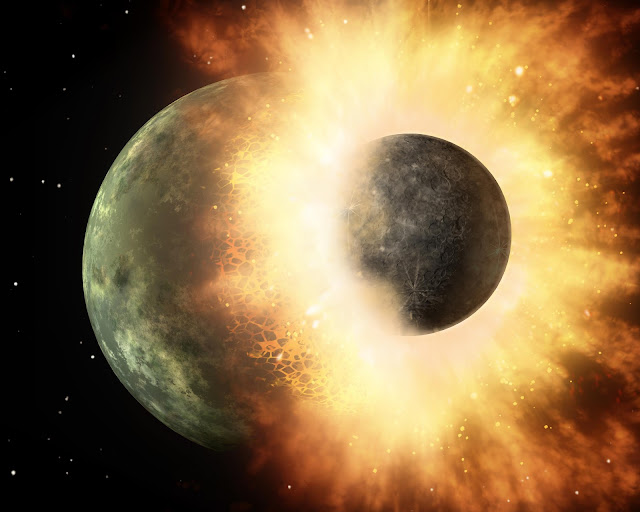Early Earth - Theia collision
The giant-impact hypothesis, sometimes called the Big Splash, or the Theia Impact suggests that the Moon formed out of the debris left over from a collision between Earth and an astronomical body the size of Mars, approximately 4.5 billion years ago, in the Hadean eon; about 20 to 100 million years after the solar system coalesced. The colliding body is sometimes called Theia, from the name of the mythical Greek Titan who was the mother of Selene, the goddess of the Moon. Analysis of lunar rocks, published in 2016, suggests that the impact may have been a direct hit, causing a thorough mixing of both parent bodies.
As of 2001 the giant-impact hypothesis is the favoured scientific hypothesis for the formation of the Moon. Supporting evidence includes:
- Earth's spin and the Moon's orbit have similar orientations.
- Moon samples indicate that the Moon once had a molten surface.
- The Moon has a relatively small iron core.
- The Moon has a lower density than Earth.
- Evidence exists of similar collisions in other star systems (that result in debris disks).
- Giant collisions are consistent with the leading theories of the formation of the solar system.
- The stable-isotope ratios of lunar and terrestrial rock are identical, implying a common origin.
There remain several questions concerning the best current models of the giant-impact hypothesis, however. The energy of such a giant impact is predicted to have heated Earth to produce a global "ocean" of magma, and evidence of the resultant planetary differentiation of the heavier material sinking into Earth's mantle has been documented. However, as of 2015 there is no self-consistent model that starts with the giant-impact event and follows the evolution of the debris into a single moon. Other remaining questions include when the Moon lost its share of volatile elements and why Venus—which experienced giant impacts during its formation—does not host a similar moon.
Indirect evidence for the giant impact scenario comes from rocks collected during the Apollo Moon landings, which show oxygen isotope ratios nearly identical to those of Earth. The highly anorthositic composition of the lunar crust, as well as the existence of KREEP-rich samples, suggest that a large portion of the Moon once was molten; and a giant impact scenario could easily have supplied the energy needed to form such a magma ocean. Several lines of evidence show that if the Moon has an iron-rich core, it must be a small one. In particular, the mean density, moment of inertia, rotational signature, and magnetic induction response of the Moon all suggest that the radius of its core is less than about 25% the radius of the Moon, in contrast to about 50% for most of the other terrestrial bodies. Appropriate impact conditions satisfying the angular momentum constraints of the Earth–Moon system yield a Moon formed mostly from the mantles of the Earth and the impactor, while the core of the impactor accretes to the Earth.
Comparison of the zinc isotopic composition of Lunar samples with that of Earth and Mars rocks provides further evidence for the impact hypothesis. Zinc is strongly fractionated when volatilized in planetary rocks, but not during normal igneous processes, so zinc abundance and isotopic composition can distinguish the two geological processes. Moon rocks contain more heavy isotopes of zinc, and overall less zinc, than corresponding igneous Earth or Mars rocks, which is consistent with zinc being depleted from the Moon through evaporation, as expected for the giant impact origin.
Collisions between ejecta escaping Earth's gravity and asteroids would have left impact heating signatures in stony meteorites; analysis based on assuming the existence of this effect has been used to date the impact event to 4.47 billion years ago, in agreement with the date obtained by other means.
Warm silica-rich dust and abundant SiO gas, products of high velocity (> 10 km/s) impacts between rocky bodies, have been detected by the Spitzer Space Telescope around the nearby (29 pc distant) young (~12 My old) star HD172555 in the Beta Pictoris moving group. A belt of warm dust in a zone between 0.25AU and 2AU from the young star HD 23514 in the Pleiades cluster appears similar to the predicted results of Theia's collision with the embryonic Earth, and has been interpreted as the result of planet-sized objects colliding with each other. A similar belt of warm dust was detected around the star BD +20°307 (HIP 8920, SAO 75016).
Image Credit: NASA/JPL-Caltech
Explanation from: https://en.wikipedia.org/wiki/Giant-impact_hypothesis




Comments
Post a Comment